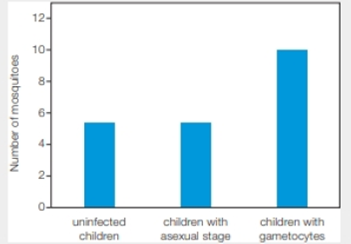
Summoning Moaquitoes
Dr. Jacob Koella and his associates hypothesized that Plasmodium might benefit by making its human host more attractive to hungry mosquitoes when gametocytes are available in the host’s blood. Gametocytes taken up by the mosquito will mature into gametes and mate inside its gut.
To test their hypothesis, the researchers recorded the response or mosquitoes to the odor or Plasmodium-infected children and uninfected children over the course of 12 trials on 12 separate days. FIRGURE 21.18 shows their results.

FIGURE 21.18 Attracting mosquitoes. The graph shows that the number of mosquitoes (out 100) attracted to uninfected children, children harboring the aseoual stage of Plasmodium, and children with gametocytes in their blood. The bars show the average number of mosquitoes attracted to that category of child over the course of 12 separate trials.
On average, which group of children was most attractive to mosquitoes?
To determine: The group of children who were the most attractive to mosquitoes.
Introduction: Plasmodium is one among the genus of unicellular eukaryotes that are obligate parasites of vertebrates and insects. It infects humans and is responsible for most malarial infections. It is transmitted through the bite of the female Anopheles mosquito. The life cycle involves the mosquito and the human as a host. During the blood meal, the malaria-infected mosquito inoculates sporozoites into the human host. The sporozoite infects the liver cells and matures into schizonts that rupture and releases the merozoites.
Explanation of Solution
In this study, the groups of children who have gametocytes in their blood were more attractive to the mosquitoes. Gametocytes that arise from the erythrocytic asexual stage are responsible for the transmission of the parasite from the mammalian host to the mosquito. The graph shows the number of mosquitoes in the y-axis, and the children with gametocytes, children with asexual stage, and uninfected children in the x-axis. The graph shows that children with gametocytes of Plasmodium are more attracted to mosquitoes.
The children with gametocytes present in their blood are most attractive to mosquitoes.
Want to see more full solutions like this?
Chapter 21 Solutions
Biology: The Unity and Diversity of Life (Looseleaf)
Additional Science Textbook Solutions
Biological Science (6th Edition)
Fundamentals Of Thermodynamics
Genetics: From Genes to Genomes
Microbiology Fundamentals: A Clinical Approach
Human Physiology: An Integrated Approach (8th Edition)
- 4.arrow_forward2arrow_forward1. 2. 3. Marine fish cells are hypotonic compared to their seawater environment; their cells lose water by osmosis and gain solutes. If you add heterotrophic respiration and autotrophic respiration together and then subtract that value from gross primary productivity, then you have a more refined estimate of ecosystem carbon storage than NEE. Differential heating due to the earth's tilt generates the global wind AND oceanic circulation patternsarrow_forward
- KD 200- 116- 66- Vec ATF6 (670) ATF6 (402) ATF6 (373) ATF6 (366) I I 45- 1 2 3 4 5 ATFG (360) (e/c) 9V ATFG (402) g ant- ATF anti-KDEL DAPI barrow_forwardWestern blot results: what information can you get? Presence of proteins of your interest Levels of protein expression Levels of protein activation (must use activation state-specific antibody) Decreased function of the ATM kinase in aging mice. A C57BL/6 female 6 month Con IR 20 month C57BL/6 male 6 month 28 month Con IR Con IR Con IR p-ATM (S1981) ATM P-p53 (ser18) Actinarrow_forwardDoes it show the level of proteins? What about the amount? Levels of protein activation? How can you tell? Does the thickness tell you anything? What about the number of the lines?arrow_forward

 Biology Today and Tomorrow without Physiology (Mi...BiologyISBN:9781305117396Author:Cecie Starr, Christine Evers, Lisa StarrPublisher:Cengage Learning
Biology Today and Tomorrow without Physiology (Mi...BiologyISBN:9781305117396Author:Cecie Starr, Christine Evers, Lisa StarrPublisher:Cengage Learning Concepts of BiologyBiologyISBN:9781938168116Author:Samantha Fowler, Rebecca Roush, James WisePublisher:OpenStax College
Concepts of BiologyBiologyISBN:9781938168116Author:Samantha Fowler, Rebecca Roush, James WisePublisher:OpenStax College





